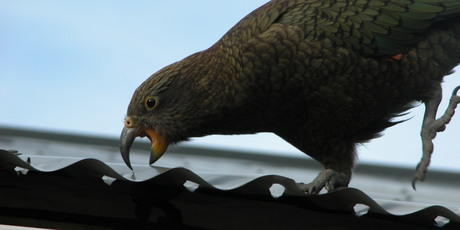Lead's lethal lure for curious kea
 Wednesday, April 4, 2012 at 14:14
Wednesday, April 4, 2012 at 14:14  A kea doing what kea do. However there's a fear the bird's natural curiosity for pulling things apart might be elevating poisonous lead levels in their blood.The curiosity of kea is putting the native parrot at risk of lead poisoning, according to new research.
A kea doing what kea do. However there's a fear the bird's natural curiosity for pulling things apart might be elevating poisonous lead levels in their blood.The curiosity of kea is putting the native parrot at risk of lead poisoning, according to new research.
Endemic to South Island hill country, kea are known to pick and pull at objects with their beaks.
However, research published by the New Zealand Journal of Ecology has found the kea habit of eating lead-head roof nails and flashings is putting the rare bird at risk of lead poisoning.
A survey of the parrots in seven South Island locations - Fox Glacier/Franz Josef area, Aoraki/Mt Cook National Park, Golden Bay, Hohonu Range, Arawhata Valley, Rob Roy Valley and Treble Cone ski field - found all keas tested in populated areas had elevated lead levels.
According to the study, undertaken by researchers from the Department of Conservation and the New Zealand Wildlife Health Centre at Massey University, 64 per cent of kea in populated areas had blood lead levels high enough to cause poisoning and 22 per cent had elevated levels.
Those in populated areas had significantly higher levels than those in remote areas.
A blood sample was taken from 88 birds between April 2006 and June 2009. A further 20 kea were autopsied and 11 of those had liver and/or kidney lead levels reported to cause lead poisoning in other birds.
Lead is reported to have a sweet taste that is appealing to kea.
Beak marks have been found on nails, and researchers believe lead shot from kea carcasses may also be being consumed by kea.
Lead that has serious effects on the nervous, renal, gastrointestinal and reproductive systems of birds. Even at low levels, lead can have effects on the bird's peripheral and central nervous system.
One kea with levels high enough to cause lead poisoning had uncoordinated movements, and another was unable to fly. One exhibited abnormal behaviour - such as staying out in full sun at a time of day when kea would normally seek shade in the beech forest and making strange sounds.
Lead poisoning has also been reported in wild kaka and in one case, a wild kakapo.
Department of Conservation wildlife veterinarian Kate McInnes said the research was sparked by necropsies on kea 10-15 years ago, which had determined some birds had been killed directly from lead poisoning.
Ms McInnes said researchers were surprised to discover how many kea were affected by lead poisoning.
"When we got the first result that was really high, we had a little blood lead analyser machine that we could take into the field - it was beyond the scale of that machine, we were quite shocked by that. We managed to catch 12 birds on that trip and all of them had lead levels, so it became very quickly apparent that in that particular place (Aoraki/Mt Cook village) there was a problem.
"We then went the next step - if this place is a problem, where are the other places where there will be problems as well and what are the common features of the problem places that mean we can target in some way to get rid of the lead."
With only an estimated 3,000 of the native birds left in the wild, even a small decline in the population of the slow-reproducing species could have a major impact on the bird's survival.
Ms McInnes said it would be hard to tell just how much of an impact lead poisoning is having on kea population.
"Keas nest on the ground and in burrow so they're very vulnerable to predation, so we've always concentrated on predators as the main cause of decline in New Zealand.
"We definitely do have animals that die from [lead poisoning] and we just don't know how much it affects their ability to survive."
As well as directly killing the birds, lead poisoning inhibits the kea's remarkable intelligence, hindering its ability to survive in its harsh habitat, Ms McInnes said.
"If we're affecting their intelligence through lead poisoning ... we could be seeing kea that basically aren't as smart trying to survive in an environment that has set up a challenge for them already."
The researchers are calling for an urgent reduction in the use of lead in areas where human settlement overlaps with kea habitat.
Fortunately, lead nails and flashing are no longer used on modern buildings.
Ms McInnes said DOC is replacing lead nails and flashing on their huts as part of maintenance, and the Kea Conservation Trust is working on mustering volunteers to replace lead fixtures in kea areas.
She recommends bach and hut owners in kea habitat areas also replace any lead on their buildings.
The research also reinforces the importance of the public not feeding kea in the wild.
"If you've got lots of people around and potential food sources, the kea get hooked into hanging around and eating people's left-over meat pies and muffins, and they've got such a high energy level they've got so much more time just to play. It's when they're playing that they do stupid things like eating lead-head nails."
 Nestor notabilis - Kea | in
Nestor notabilis - Kea | in  Conservation,
Conservation,  Poisoning
Poisoning 
